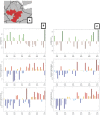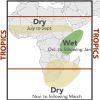Using Rainfall and Temperature Data in the Evaluation of National Malaria Control Programs in Africa
- PMID: 28990912
- PMCID: PMC5619931
- DOI: 10.4269/ajtmh.16-0696
Using Rainfall and Temperature Data in the Evaluation of National Malaria Control Programs in Africa
Abstract
Since 2010, the Roll Back Malaria (RBM) Partnership, including National Malaria Control Programs, donor agencies (e.g., President's Malaria Initiative and Global Fund), and other stakeholders have been evaluating the impact of scaling up malaria control interventions on all-cause under-five mortality in several countries in sub-Saharan Africa. The evaluation framework assesses whether the deployed interventions have had an impact on malaria morbidity and mortality and requires consideration of potential nonintervention influencers of transmission, such as drought/floods or higher temperatures. Herein, we assess the likely effect of climate on the assessment of the impact malaria interventions in 10 priority countries/regions in eastern, western, and southern Africa for the President's Malaria Initiative. We used newly available quality controlled Enhanced National Climate Services rainfall and temperature products as well as global climate products to investigate likely impacts of climate on malaria evaluations and test the assumption that changing the baseline period can significantly impact on the influence of climate in the assessment of interventions. Based on current baseline periods used in national malaria impact assessments, we identify three countries/regions where current evaluations may overestimate the impact of interventions (Tanzania, Zanzibar, Uganda) and three countries where current malaria evaluations may underestimate the impact of interventions (Mali, Senegal and Ethiopia). In four countries (Rwanda, Malawi, Mozambique, and Angola) there was no strong difference in climate suitability for malaria in the pre- and post-intervention period. In part, this may be due to data quality and analysis issues.
Figures







Similar articles
-
Implementing Impact Evaluations of Malaria Control Interventions: Process, Lessons Learned, and Recommendations.Am J Trop Med Hyg. 2017 Sep;97(3_Suppl):20-31. doi: 10.4269/ajtmh.17-0064. Am J Trop Med Hyg. 2017. PMID: 28990921 Free PMC article.
-
Folic acid supplementation and malaria susceptibility and severity among people taking antifolate antimalarial drugs in endemic areas.Cochrane Database Syst Rev. 2022 Feb 1;2(2022):CD014217. doi: 10.1002/14651858.CD014217. Cochrane Database Syst Rev. 2022. PMID: 36321557 Free PMC article.
-
Climate change and malaria: some recent trends of malaria incidence rates and average annual temperature in selected sub-Saharan African countries from 2000 to 2018.Malar J. 2023 Aug 28;22(1):248. doi: 10.1186/s12936-023-04682-4. Malar J. 2023. PMID: 37641080 Free PMC article.
-
Diagnosis and Treatment of the Febrile Child.In: Black RE, Laxminarayan R, Temmerman M, Walker N, editors. Reproductive, Maternal, Newborn, and Child Health: Disease Control Priorities, Third Edition (Volume 2). Washington (DC): The International Bank for Reconstruction and Development / The World Bank; 2016 Apr 5. Chapter 8. In: Black RE, Laxminarayan R, Temmerman M, Walker N, editors. Reproductive, Maternal, Newborn, and Child Health: Disease Control Priorities, Third Edition (Volume 2). Washington (DC): The International Bank for Reconstruction and Development / The World Bank; 2016 Apr 5. Chapter 8. PMID: 27227231 Free Books & Documents. Review.
-
Conquering the intolerable burden of malaria: what's new, what's needed: a summary.Am J Trop Med Hyg. 2004 Aug;71(2 Suppl):1-15. Am J Trop Med Hyg. 2004. PMID: 15331814 Review.
Cited by
-
Malaria, climate variability, and interventions: modelling transmission dynamics.Sci Rep. 2023 May 5;13(1):7367. doi: 10.1038/s41598-023-33868-8. Sci Rep. 2023. PMID: 37147317 Free PMC article.
-
Impact of malaria control interventions on malaria infection and anaemia in low malaria transmission settings: a cross-sectional population-based study in Sudan.BMC Infect Dis. 2022 Dec 10;22(1):927. doi: 10.1186/s12879-022-07926-x. BMC Infect Dis. 2022. PMID: 36496398 Free PMC article.
-
A cluster randomised controlled trial of two rounds of mass drug administration in Zanzibar, a malaria pre-elimination setting-high coverage and safety, but no significant impact on transmission.BMC Med. 2018 Dec 10;16(1):215. doi: 10.1186/s12916-018-1202-8. BMC Med. 2018. PMID: 30526588 Free PMC article. Clinical Trial.
-
Assessing the Health Impact of Malaria Control Interventions in the MDG/Sustainable Development Goal Era: A New Generation of Impact Evaluations.Am J Trop Med Hyg. 2017 Sep;97(3_Suppl):6-8. doi: 10.4269/ajtmh.17-0509. Am J Trop Med Hyg. 2017. PMID: 28990917 Free PMC article. No abstract available.
-
Thermal biology of mosquito-borne disease.Ecol Lett. 2019 Oct;22(10):1690-1708. doi: 10.1111/ele.13335. Epub 2019 Jul 8. Ecol Lett. 2019. PMID: 31286630 Free PMC article. Review.
References
-
- Rowe AK, et al. , Roll Back Malaria Monitoring and Evaluation Reference Group, 2007. Viewpoint: evaluating the impact of malaria control efforts on mortality in sub-Saharan Africa. Trop Med Int Health 12: 1524–1539. - PubMed
-
- Coetzee M, Craig M, Sueur D, 2000. Distribution of African malaria mosquitoes belonging to the Anopheles gambiae complex. Parasitol Today 16: 74–77. - PubMed
-
- Thomson MC, Connor SJ, Milligan PJM, Flasse SP, 1996. The ecology of malaria: as seen from Earth-observation satellites. Ann Trop Med Parasitol 90: 243–264. - PubMed
MeSH terms
LinkOut - more resources
Full Text Sources
Other Literature Sources
Medical

